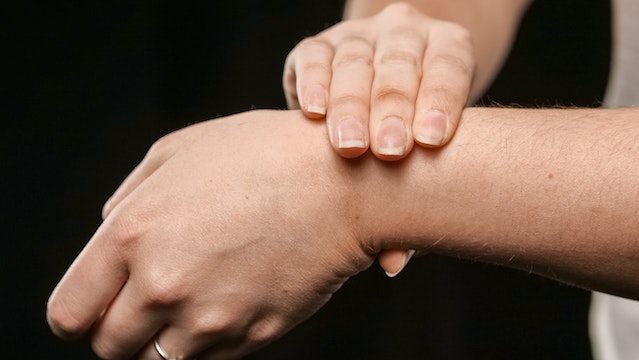CTS refers to a combination of symptoms not hard to identify linked to nerve compression in the hand. Our hands and wrists are composed of tiny bones, tendons, and nerves. The particular combination of bones in the wrist gives form to the carpal tunnel. Sometimes, if the tendons that pass through it get inflamed, they will press the median nerve, which allows us to sense through our palm and fingers, and cause wrist tendon pain and other CTS symptoms.
What are the most common carpal tunnel syndrome symptoms?
Many conditions can cause wrist tendon pain, such as injury, wrist tendonitis, arthritis, etc. However, carpal tunnel syndrome has characteristic symptoms that you can distinguish yourself.
The most common symptoms are:
- Numbness usually up to the three fingers of the hand
- Wrist tendon pain
- Tingling sensation in the hand or fingers
- Weakness in the use of the hand, especially of the thumb
- Pain in hand and wrist
- All can be accompanied by swelling or a change in skin color.
Who is most likely to develop wrist tendon pain caused by carpal tunnel syndrome?
Recent studies show women are more likely to develop wrist tendon pain. In fact, they are three times more likely to develop it compared to men! Older people, people who work in high-strain jobs or perform repetitive movements and or do hand-intensive activities after work, are also more susceptible to wrist pain. Examples of hand-intensive activities are gardening, gaming, or operating vibrating machinery.
Some people might have a genetic predisposition. For example, people born with a smaller carpal tunnel might develop CTS. Injuries such as a sprained or fractured wrist can cause CTS simply because trauma can pressure the median nerve.
Another reason can be linked to hormonal changes during pregnancy or menopause. These changes cause the enlargement of the wrist structure and the pressure on the nerves. Other conditions are enlargement of the wrist structure, obesity, diabetes or hypothyroidism, and rheumatoid arthritis.
How to prevent CTS?
Besides the fact that several studies showed that women are more likely to have CTS, especially after 45, men should also watch out for it. Prevention is the key!
The first place where prevention starts is at work: for those who work on a computer every day, a way to prevent CTS is to keep the wrists in a neutral position while using a computer mouse and keyboard. Many tools and wristbands, such as Uppo, allow this and help prevent CTS.
Taking breaks is also important, especially when working in a repetitive job involving using hands. Avoiding repetitive movements lowers the risk of CTS, and when not possible, doing exercise helps alleviate the damage caused by those movements.
How to cure wrist tendon pain?
Wrist support bands and rests help support the neutral position of the wrist so that the nerve and tendons are relaxed and CTS will not degenerate. When possible, rest is beneficial but, unfortunately, not always possible, so in this case, short-term medication and anti-inflammatory drugs reduce the pain.
When CTS is very severe, surgery is the recommended course of action. It is done with a local anesthetic and allows the person to return home the same day of the surgery.
Exercises for wrist tendon pain
Although wrist pain doesn’t necessarily mean you have carpal tunnel syndrome, it can signal that you need to pay more attention to your wrists. Exercise is a surefire way to prevent and alleviate carpal tunnel syndrome wrist pain.
Here are three exercises you can do at home or work for a few minutes daily.
Prayer stretch
- For this exercise, you can either sit or stand.
- Put your hands in front of you in a prayer position. They should be a bit lower than your chin.
- Lower the closed hands towards your belly.
- Keep it in position for a few seconds.
- Lift the closed hands and repeat the stretch 3-4 times.
Wrist stretch
- Extend one of your arms in front of you, palms up.
- Bend the wrist to the opposite side.
- With the free hand, deepen the stretch.
- Keep your hand in position for a few seconds and then release it.
- Repeat the stretch 3-4 times on both hands.
Hand circles
- Interlace your fingers.
- Rotate your wrists together in the shape of infinity.
- After a few circles, change the direction.
- Extend your hands.
- Open and clench your fingers.
- Repeat 3-4 times.
Wrist exercises are good for reducing swelling and increasing wrist flexibility. However, if you suffer from severe pain, monitor your pain level and start slow. It’s better to do one round of exercises and increase from there.
Uppo wrist support band for wrist tendon pain
Wrist pain can damage your working performance and steal joy from everyday activities. You shouldn’t succumb to the pain. And we want to help you improve your life quality. Uppo wrist rest is designed for people who suffer from carpal tunnel syndrome and wrist pain. It’s a great addition to your office equipment if you spend a lot of time at the computer. Our wrist rest is different from other alternatives in the market. You can put Uppo on your wrist, and it stays in place the whole time you’re working. You don’t need to move it or change its place. Check our options online and forget wrist pain!




